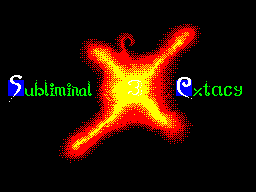|
01 апреля 2001 |
|

Cheat's Guide To TR-DOS Cracking: An Incomprehensible Techy
Article By Gasman / RA
There's a heated debate going on elsewhere in this magazine
about using custom loading routines on TR-DOS demos, and I don't
propose to continue it here. Clearly it *would* be nice if all
demo coders were to supply their releases in both speed-loading
custom TR-DOS versions and portable BASIC-loader versions.
Whether or not that happens in the near future, we'll still be
left with a backlog of old demos which only exist in TR-DOS
form.
To deal with this, we'd have to learn about every trick in the
TR-DOS system, and then disassemble the loader to each demo,
extracting each code block and rewriting the loader in BASIC.
Or we can cheat.
To begin with, here's a list of the things you need - or the
things I use, anyway. Some demos in TRD format, R80 emulator
WinZ80 (the unregistered shareware version will probably do) Z80
Bintap by Lee 'Blood' Tonks. There may well be a simpler method
to do all this which doesn't involve hopping between three
different emulators. I just happen to like the debugger that
comes with WinZ80, that's all.
Okay then. What we're essentially looking for is a copy of the
demo stored after all the code has been loaded, but before the
demo itself has started. By the way, this method only works for
demos that load in one go - multiloads will need a bit of
fiddling with the loader, and I'd rather not go into that until,
er, I've tried it myself.
To work out where the demo starts, you just guess. Programmers
like nice round numbers, so it almost certainly starts at 24576
(#6000), 25000 (#61A8), 26000 (#6590), 32768 (#8000), or if
you're unlucky, 23296 (#5B00), which is probably the least
helpful place in the entire memory. So, start up R80, and use
the built-in monitor to bung in a few breakpoints at those
addresses. Then load the demo from the TRD file, and hopefully
it will stop at one of the breakpoints. However, at this point
you don't know whether all the code has finished loading, so you
need to check by making a snapshot, and loading this into
another emulator, such as WinZ80. If the demo runs OK, you've
found the right place. If not, go back to R80 and try the next
breakpoint that comes up.
A little note at this point: R80 doesn't let you save snapshots
from within the monitor. You can get around this as follows:
Let's say the demo has stopped at address #6000. Note down the
first few assembler instructions at this point, and then go into
the memory editor section and edit the code at #6000 to become
the hex codes 18FE. This happens to be a 'JR -2' instruction,
which is our old friend, the infinite loop. Now, you can return
to the emulator with the program safely stopped in its tracks,
and make the snapshot. Load this into WinZ80, and use the
debugger to put the code back to how it was before (y'know, the
bit that you wrote down).
So, now you should have a snapshot that works in WinZ80. Now for
the boring bit! Flick through the memory noting down the bits
that contain data. There's bound to be some un-necessary stuff,
such as the code from the loader, so try deleting likely looking
bits (a good way is to type 'asm nop' into the debugger and hold
down enter until you've overwritten what you want) and seeing if
it still runs. Yep, that means lots of trial and error. And to
make matters worse, bear in mind that if it's a 128K demo - and
what isn't nowadays? - you have to trawl through all the memory
pages too. To get at the extra pages, you'll need to put in a
bit of code at #6000 (or wherever): LD BC,#7FFD LD A,page
;(this is a page number, from #10 to #17) OUT (C),A For every
page that contains some data, make a snapshot - you'll need it
in a minute. While you're at it, make a note of which page was
there to begin with.
The next step is to save out the individual blocks of data that
you've found. There doesn't seem to be an easy way of doing this
in WinZ80, so it's time to move to yet another emulator - Z80
(the DOS version). If you load a snapshot by typing F10 then L
(rather than F3), you'll get back to the Z80 main menu, from
which you can press X, then save the required blocks of memory
to disc. Now you've got the raw data blocks, so run them through
Bintap to turn them into lovely TAP files.
And that's it... sort of! If you load all the blocks into the
right place, then RANDOMIZE USR 'start' , the demo should work.
Of course, it's a bit silly to keep it as ten zillion small
blocks, so if you want to do the job properly, you'll bundle
them all together with a decent compressor, and a bit of code to
move things into the right place. But that's another story...
gasman
Other articles:
|
|
|
|
|
|
|
|
|
|
|
|
|
|
|
|
|
|
|
|
|
|
|
|
|
|
|
|
|
|
|
|
|
|
|
|
|
|
|
|
|
|
|
|
|
|
|
|
|
|
|
|
|
|
|
|
|
|
|
|
|
|
|
|
|
|
|
|
|
|
|
|
|
|
|
|
|
|
|
|
|
|
|
|
|
|
|
|
|
|
|
|
Similar articles:
В этот день... 31 December